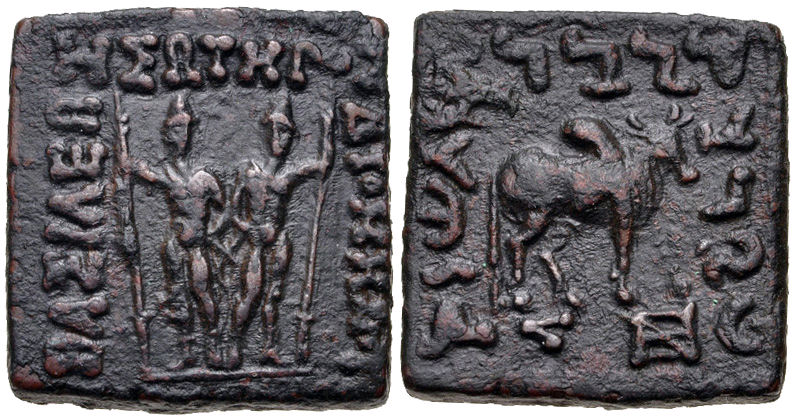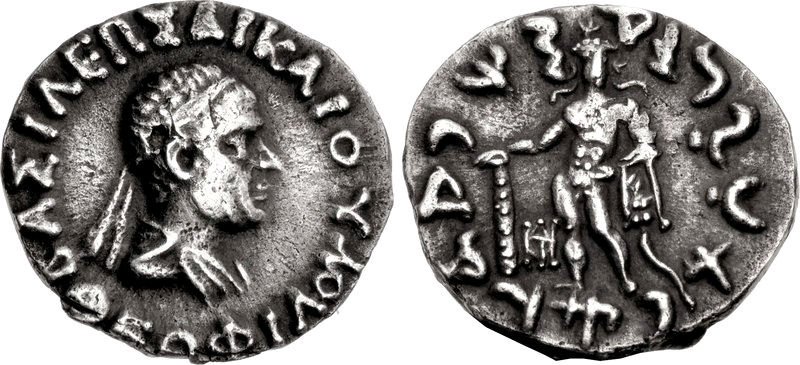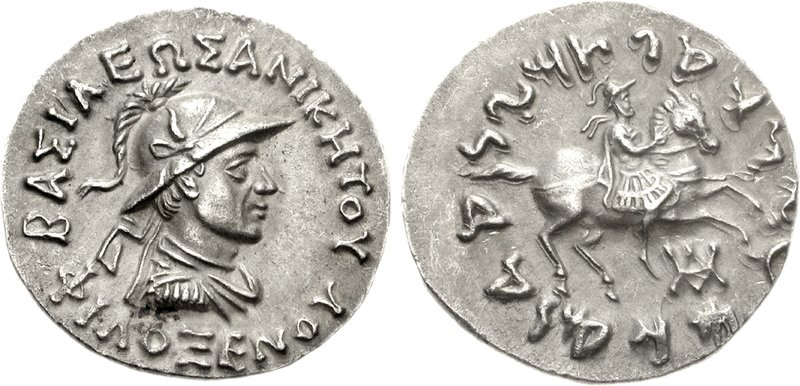|
Diomedes Soter
Diomedes Soter or Diodotus (Greek: ; epithet means "the Saviour") was an Indo-Greek king and possible claimant Greco-Bactrian King who may have attempted to reconquer the lands north of the Hindu Kush. The places where his coins have been found seem to indicate that his rule was based in the area of the Paropamisadae, possibly with temporary dominions further east. Judging from their similar portraits and many overlapping monograms, the young Diomedes seems to have been the heir (and probably a relative) of Philoxenus, the last king to rule before the kingdom of Menander I finally fragmented. Time of reign Bopearachchi dates Diomedes to c. 95–90 BCE and R. C. Senior dates him to c. 115–105 BCE. Coins of Diomedes (Diodotus) Diomedes either born Diodotus or reigning as such; perhaps erroneously labelled on legend as Diomedes, is depicted with the Dioscuri on his coins, either on horseback or standing; both types were previously used by Eucratides the Great, which strongly sug ... [...More Info...] [...Related Items...] OR: [Wikipedia] [Google] [Baidu] |
Indo-Greek
The Indo-Greek Kingdom, or Graeco-Indian Kingdom, also known historically as the Yavana Kingdom (Yavanarajya), was a Hellenistic period, Hellenistic-era Ancient Greece, Greek kingdom covering various parts of Afghanistan and the northwestern regions of the Indian subcontinent (parts of modern-day Pakistan and northwestern India). This kingdom was in existence from ca. 200 BC to ca. 1 BC. During its existence the kingdom was ruled over by 30 successive kings. Menander I, being the most well known amongst the Indo-Greek kings, is often referred to simply as ''“Menander,”'' despite the fact that there was indeed another Indo-Greek King known as Menander II. Menander I's capital was at Sagala in the Punjab region, Punjab (present-day Sialkot). The kingdom was founded when the Graeco-Bactrian king Demetrius I of Bactria, Demetrius (and later Eucratides I, Eucratides) invaded India from Bactria in 200 BC. The Greeks in the Indian Subcontinent were eventually divided from the G ... [...More Info...] [...Related Items...] OR: [Wikipedia] [Google] [Baidu] |
Kharoshthi
The Kharoṣṭhī script, also spelled Kharoshthi (Kharosthi: ), was an ancient Indo-Iranian script used by various Aryan peoples in north-western regions of the Indian subcontinent, more precisely around present-day northern Pakistan and eastern Afghanistan. It was used in Central Asia as well. An abugida, it was introduced at least by the middle of the 3rd century BCE, possibly during the 4th century BCE, and remained in use until it died out in its homeland around the 3rd century CE. It was also in use in Bactria, the Kushan Empire, Sogdia, and along the Silk Road. There is some evidence it may have survived until the 7th century in Khotan and Niya, both cities in East Turkestan. Form Kharosthi (, from right to left ''Kha-ro-ṣṭhī'') is mostly written right to left (type A). Each syllable includes the short /a/ sound by default, with other vowels being indicated by diacritic marks. Recent epigraphic evidence has shown that the order of letters in the Kharosthi ... [...More Info...] [...Related Items...] OR: [Wikipedia] [Google] [Baidu] |
Indo-Greek Kings
The Indo-Greek Kingdom, or Graeco-Indian Kingdom, also known historically as the Yavana Kingdom (Yavanarajya), was a Hellenistic-era Greek kingdom covering various parts of Afghanistan and the northwestern regions of the Indian subcontinent (parts of modern-day Pakistan and northwestern India). This kingdom was in existence from ca. 200 BC to ca. 1 BC. During its existence the kingdom was ruled over by 30 successive kings. Menander I, being the most well known amongst the Indo-Greek kings, is often referred to simply as ''“Menander,”'' despite the fact that there was indeed another Indo-Greek King known as Menander II. Menander I's capital was at Sagala in the Punjab (present-day Sialkot). The kingdom was founded when the Graeco-Bactrian king Demetrius (and later Eucratides) invaded India from Bactria in 200 BC. The Greeks in the Indian Subcontinent were eventually divided from the Graeco-Bactrians centered on Bactria (now the border between Afghanistan and Uzbekistan) ... [...More Info...] [...Related Items...] OR: [Wikipedia] [Google] [Baidu] |
Theophilos (king)
Theophilus Dicaeus ( grc, Θεόφιλος Δίκαιος, Theophilos Dikaios) was a minor Indo-Greek king who ruled for a short time in the Paropamisadae. He was possibly a relative of Zoilus I and is only known from coins. It is possible that some of Theophilus' coins in fact belong to another ruler, in Greek Bactria, during approximately the same period. Time of reign While Bopearachchi suggests c. 90 BCE, R. C. Senior believes that Theophilus ruled in the 130s BCE. Both numismatics do however suggest that the reigns of Theophilus and Nicias were adjacent. Coins of Theophilos Just like Zoilus I, Theophilus struck Indian silver coins with Heracles, a common symbol of the house of Euthydemus I, and the epithet Dikaios/Dhramikasa ''"The Just/Follower of the Dharma".'' The monograms are mostly the same as those of Nicias. The bronzes have similar inscriptions. Bronzes of Theophilos: Image:Theophilos-634.jpg, Heracles with lion skin, and his club on the reverse. A Bactrian ki ... [...More Info...] [...Related Items...] OR: [Wikipedia] [Google] [Baidu] |
Indo-Greek Kingdom
The Indo-Greek Kingdom, or Graeco-Indian Kingdom, also known historically as the Yavana Kingdom (Yavanarajya), was a Hellenistic-era Greek kingdom covering various parts of Afghanistan and the northwestern regions of the Indian subcontinent (parts of modern-day Pakistan and northwestern India). This kingdom was in existence from ca. 200 BC to ca. 1 BC. During its existence the kingdom was ruled over by 30 successive kings. Menander I, being the most well known amongst the Indo-Greek kings, is often referred to simply as ''“Menander,”'' despite the fact that there was indeed another Indo-Greek King known as Menander II. Menander I's capital was at Sagala in the Punjab (present-day Sialkot). The kingdom was founded when the Graeco-Bactrian king Demetrius (and later Eucratides) invaded India from Bactria in 200 BC. The Greeks in the Indian Subcontinent were eventually divided from the Graeco-Bactrians centered on Bactria (now the border between Afghanistan and Uzbekistan) ... [...More Info...] [...Related Items...] OR: [Wikipedia] [Google] [Baidu] |
Philoxenus Anicetus
Philoxenus Anicetus (Greek: ; epithet means "the Invincible") was an Indo-Greek king who ruled in the region spanning the Paropamisade to Punjab. Philoxenus seems to have been quite an important king who might briefly have ruled most of the Indo-Greek territory. Bopearachchi dates Philoxenus to c. 100–95 BCE and R. C. Senior to c. 125–110 BCE. Historians have not yet connected Philoxenus with any dynasty, but he could have been the father of the princess Kalliope, who was married to the king Hermaeus. Coins of Philoxenos Philoxenus struck several series of bilingual Indian silver coins, with a reverse of a mounted king, a type previously used as obverse by Antimachus II sixty years earlier and as reverse on rare types of Nicias. Whether the horseman was a dynastic emblem or a portrait of the king as a cavalryman is unclear. Several Saka kings used similar horsemen on their coinage. His drachms were square, another feature that was rare among Indo-Greeks but standard for ... [...More Info...] [...Related Items...] OR: [Wikipedia] [Google] [Baidu] |
Seleucid Empire
The Seleucid Empire (; grc, Βασιλεία τῶν Σελευκιδῶν, ''Basileía tōn Seleukidōn'') was a Greek state in West Asia that existed during the Hellenistic period from 312 BC to 63 BC. The Seleucid Empire was founded by the Macedonian general Seleucus I Nicator, following the division of the Macedonian Empire originally founded by Alexander the Great. After receiving the Mesopotamian region of Babylonia in 321 BC, Seleucus I began expanding his dominions to include the Near Eastern territories that encompass modern-day Iraq, Iran, Afghanistan, Syria, all of which had been under Macedonian control after the fall of the former Persian Achaemenid Empire. At the Seleucid Empire's height, it had consisted of territory that had covered Anatolia, Persia, the Levant, and what are now modern Iraq, Kuwait, Afghanistan, and parts of Turkmenistan. The Seleucid Empire was a major center of Hellenistic culture. Greek customs and language were privileged; the wide varie ... [...More Info...] [...Related Items...] OR: [Wikipedia] [Google] [Baidu] |
Kushan Empire
The Kushan Empire ( grc, Βασιλεία Κοσσανῶν; xbc, Κυϸανο, ; sa, कुषाण वंश; Brahmi: , '; BHS: ; xpr, 𐭊𐭅𐭔𐭍 𐭇𐭔𐭕𐭓, ; zh, 貴霜 ) was a syncretic empire, formed by the Yuezhi, in the Bactrian territories in the early 1st century. It spread to encompass much of modern-day territory of, Afghanistan, Pakistan, Uzbekistan, and northern India, at least as far as Saketa and Sarnath near Varanasi (Benares), where inscriptions have been found dating to the era of the Kushan Emperor Kanishka the Great. The Kushans were most probably one of five branches of the Yuezhi confederation, an Indo-European nomadic people of possible Tocharian origin, who migrated from northwestern China (Xinjiang and Gansu) and settled in ancient Bactria. The founder of the dynasty, Kujula Kadphises, followed Greek religious ideas and iconography after the Greco-Bactrian tradition, and being a follower of Shaivism. The Kushans in general were ... [...More Info...] [...Related Items...] OR: [Wikipedia] [Google] [Baidu] |
Indo-Scythians
Indo-Scythians (also called Indo-Sakas) were a group of nomadic Iranian peoples of Scythian origin who migrated from Central Asia southward into modern day Pakistan and Northwestern India from the middle of the 2nd century BCE to the 4th century CE. The first Saka king of India was Maues/Moga (1st century BCE) who established Saka power in Gandhara, Pakistan and the Indus Valley. The Indo-Scythians extended their supremacy over north-western India, conquering the Indo-Greeks and other local kingdoms. The Indo-Scythians were apparently subjugated by the Kushan Empire, by either Kujula Kadphises or Kanishka. Yet the Saka continued to govern as satrapies, forming the Northern Satraps and Western Satraps. The power of the Saka rulers started to decline in the 2nd century CE after the Indo-Scythians were defeated by the Satavahana emperor Gautamiputra Satakarni. Indo-Scythian rule in the northwestern Indian subcontinent ceased when the last Western Satrap Rudrasimha III was defea ... [...More Info...] [...Related Items...] OR: [Wikipedia] [Google] [Baidu] |
Indo-Parthian Kingdom
The Indo-Parthian Kingdom was a Parthian kingdom founded by Gondophares, and active from 19 CE to c. 226 CE. At their zenith, they ruled an area covering parts of eastern Iran, various parts of Afghanistan and the northwest regions of the Indian subcontinent (most of modern Pakistan and parts of northwestern India). The rulers may have been members of the House of Suren, and the kingdom has even been called the "Suren Kingdom" by some authors. The kingdom was founded in 19 when the governor of Drangiana (Sakastan) Gondophares declared independence from the Parthian Empire. He would later make expeditions to the east, conquering territory from the Indo-Scythians and Indo-Greeks, thus transforming his kingdom into an empire. The domains of the Indo-Parthians were greatly reduced following the invasions of the Kushans in the second half of the 1st. century. They managed to retain control of Sakastan, until its conquest by the Sasanian Empire in c. 224/5. In Baluchistan, the Para ... [...More Info...] [...Related Items...] OR: [Wikipedia] [Google] [Baidu] |
Greco-Buddhism
Greco-Buddhism, or Graeco-Buddhism, is the cultural syncretism between Hellenistic culture and Buddhism, which developed between the fourth century BC and the fifth century AD in Gandhara, in present-day north-western Pakistan and parts of north-east Afghanistan. It was a cultural consequence of a long chain of interactions begun by Greek forays into India from the time of Alexander the Great. A few years after Alexander's death, the Easternmost fringes of the empire of his general Seleucus were lost in a war with the Mauryan Empire, under the reign of Chandragupta Maurya. The Mauryan Emperor Ashoka would convert to Buddhism and spread the religious philosophy throughout his domain, as recorded in the Edicts of Ashoka. This spread to the Greco-Bactrian kingdom, which itself seceded from the Seleucid empire. Within its borders, the Greek fondness for statuary produced the first statues of the Buddha, leading ultimately to the modern tradition. Following the collapse of the Maur ... [...More Info...] [...Related Items...] OR: [Wikipedia] [Google] [Baidu] |
Agathokleia
Agathoclea Theotropus ( grc, Ἀγαθόκλεια Θεότροπος, Agathokleia Theotropos; the epithet possibly means ''the Goddess-like'') was an Indo-Greek queen married to Menander I, who ruled in parts of northern India in the 2nd-century BC as regent for her son Strato I. Born in Bactria, likely to a noble family (probably royal) with some authors such as Tarn alleging she was a daughter of Eucratides, however this is uncertain and Tarn is often criticised by modern authors for casually creating dynastic relationships. Nonetheless, Agathoclea would become one of the first woman ruler in the Hellenistic world, and she seems to have been relatively significant due to her large presence on the coins of Strato I. Date and genealogy The traditional view, introduced by Tarn and defended as late as 1998 by Bopearachchi, is that Agathokleia was the widow of Menander I. She may also have been the daughter of Eucratides. In the civil wars after Menander's death, the Indo-Greek ... [...More Info...] [...Related Items...] OR: [Wikipedia] [Google] [Baidu] |










.jpeg/1200px-Gandhara_Buddha_(tnm).jpeg)
